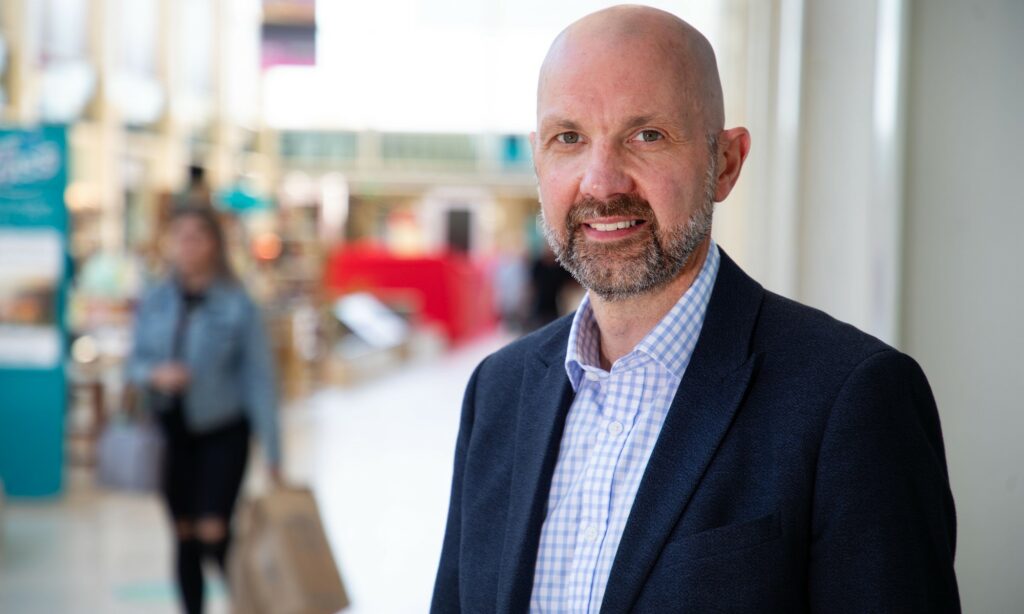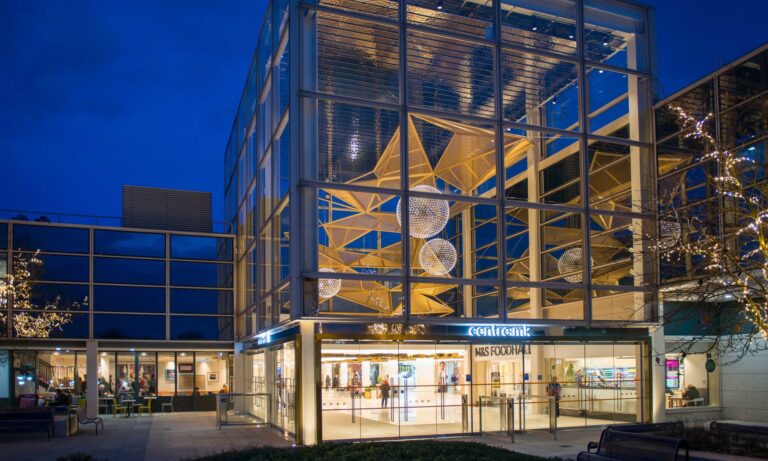A look at the Milton Keynes retail destination and the manager at its helm
The Milton Keynes Development Corporation began work on centre:mk in 1973. At the time, it was to be the largest building in central Milton Keynes. The destination was officially opened on 25 September 1979, by the then UK Prime Minister Margaret Thatcher. It received Grade II listed status in 2010.
Unlike other shopping centres, it is built on just one floor with two distinct malls creating grid like formats, though some of the larger shops have added internal second and third floors. It was designed with significant amount of natural light and features sub-tropical and temperate trees planted in the arcades. In terms of access, the centre has extensive surface level parking and a new multi-storey carpark.
Kevin Duffy, centre director at the Milton Keynes destination, says it evolved its offer and experience over the years, responding to the changing needs of consumers by signing popular brands and helping them expand, and above all being is a destination that strives to listen to its guests. “It was through our exit surveys that we saw demand for Primark, who consequently opened a 75,000 sq ft store in 2019 on Silbury Boulevard, replacing the former BHS,” Duffy tells.
With John Lewis, H Beauty, Primark and M&S, centre:mk has a strong anchor brand line-up. These are complemented by a plethora of big retail names, including JD Sports, River Island, Tessuti, Beaverbrooks, Boots, Dune, Hobbs, Crew Clothing Company and The White Company.
Over the years, there has also been a major increase in the amount of hospitality brands, with food options now including well-known favourites such as Pizza Express, Wagamama’s and Nando’s, along with independents like Giovanni’s Gelato, and Chinese street food restaurant, Robunmo.
The centre is a hub for events too. Middleton Hall is a large events space that hosts over 170 days of events a year, serving the local community with unique events such as the Milton Keynes International Festival, Style Fest and the ever-popular Santa’s Grotto which attracts over four million in footfall per year from across the country.
It has also benefitted over the years from major investment and active management by its joint owners, Federated Hermes and Australian Super, with £60 million of investment in the last five years alone. Where other shopping centres in the country have suffered multiple changes in ownership and a lack of funding, centre:mk has continued to flourish, a feat the centre team attribute to continuity in ownership and investment.
Th destination posts strong showings on key industry performance indicators. For example, in 2019, it had an annual footfall of 24 million. Trading figures for the October half-term week (October 25-31) compared to the same week in 2019 showed centre:mk’s footfall was 8% above retail analyst Springboard’s national footfall benchmark, 19% ahead of the Springboard High Street index, and 38% up on Springboard’s Shopping Centre index.
In recent years, the centre has made significant environmental improvements. More than 80% of its waste is recycled, with 100% being diverted from landfill; staff toilets use rainwater harvesting and all external lighting is LED lighting, saving an estimated 141.98 tonnes of Co2. Moving forward, it has set a target to become net zero by 2035.
Heart of the community
The centre offers both a unique city centre location, making it the heart of the community, but the scale, diversity and quality of its offer means it attracts visitors from across the South East, the Midlands and north of the M25.
“We are the centre of the local community, both physically and emotionally,” says Duffy. “Geographically, we act as the city centre high street. It is also a place where memories have been made for the local population, whether it’s enjoying a day-out shopping or earning a pay cheque, with more people working here than any other single location in Milton Keynes. centre:mk sits at the centre of everything, filling both purposes as a community driven centre and a regional destination.”
The centre continues to attract quality retailers and hospitality operators, having welcomed 14 new brands totalling 200,000 sq ft since April 2021. In the months and years ahead, Duffy says the plan is to continue to improve and evolve centre:mk’s offer and experience for the changing needs of customers, occupiers and the community. He says they are hoping to announce a major new tenant soon which will be taking 30,000 sq ft of space.
In terms of future challenges, Duffy says the biggest challenge centre:mk and retail destinations around the country face today is being able to keep up with technology: “Looking forward the biggest opportunity is continuing to adapt to new technologies which move so fast, 5G is definitely on our horizon as part of the Milton Keynes Testbed Status as is the support of integrated transport networks within the city,” says Duffy.

Interview with Kevin Duffy, centre director of centre:mk
You have been centre director at centre:mk for over six years now – what has been your career progression to this role?
I began as an assistant manager in the Meadowhall Food Court in Sheffield. Eight months into this job, I was promoted to manager. After this, I decided to move into retail. I became centre director at the Liffey Valley shopping centre in Dublin in 1998 and was referred to at the time in a press article as Europe’s youngest retail centre director.
I next went to work for the Westfield Group, becoming the centre manager of Westfield Derby from 2001 to 2008. From there, I was project centre manager at Westfield in Stratford from 2008 to 2010, overseeing the management strategy in the lead up to the opening.
Following that role, I worked for Land Securities Group for five years. From 2010-2013, I was centre director at Cabot Circus in Bristol. In 2013, I became the general manager at Trinity shopping centre in Leeds for two years, before being appointed centre director of centre:mk in 2015.
Was centre director a role you always aspired to?
Initially I didn’t. I studied catering at university, and it was this that I originally wanted to do, hence starting out as the assistant manager at Meadowhall Food Court. But I realised I love both hospitality and retail and wanted to become a centre director for much the same reasons I love my job today; the pace of the role, the varied people you meet, and the diversity of the role where no two days are the same.
What about your job do you love the most?
I love the pace of the work, the broad range of people you get to meet, and the diversity of the job. I think above all these though is the responsibility of being a key player at the destination, looking after and working with stakeholders. This includes everyone that makes centre:mk what it is: our staff and the brands we are home to, guests, and our operational teams, as well as business and civic groups across Milton Keynes.
Working with these external groups is just as important, you must make sure the city is thriving as you cannot operate in perfect isolation. It is this responsibility for driving the centre forward that I love the most.
What is the most challenging part about your job?
All the things I love about the job are also challenges in their own right. But I would say the most challenging part of the job is handling the pace of the market, making sure you have the flexibility and ability to adapt to changing retailer and consumer needs. Not spotting these trends early enough can have a significant impact. In a highly competitive market, destinations must maintain relevance, otherwise the consumer will simply go elsewhere.
What do you think are the most important issues facing retail at the moment?
Retail has had its fair share of issues in recent years, but I would say the most pressing issue, and the one that poses the biggest structural change for the sector, are changing consumer priorities around sustainability.
Young people today are very alert to the issues of climate change and our impact on the environment. We are already seeing major retailers offer incentives to customers to return used clothes. We are also seeing a growing trend from the consumer towards buying used clothes. This issue isn’t going away, and retailers will need to address this. But this can be an opportunity for companies out there; I think we could see a CEX-type business model for a clothes shop emerging soon.
Finally, if you weren’t centre director, what do you think you would you be doing?
I definitely would be doing something similar, maybe working at a leisure destination or an airport. Another job I could see myself doing is being part of the team involved in centre openings, something I did with Westfield Stratford. The task of getting centres developed and establishing a reputation is a hugely fun and challenging task.
This was first published in Retail Destination Fortnightly. Click here to subscribe.


